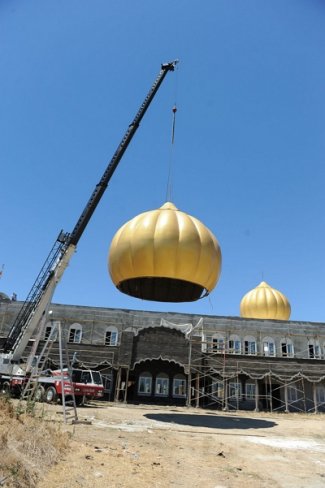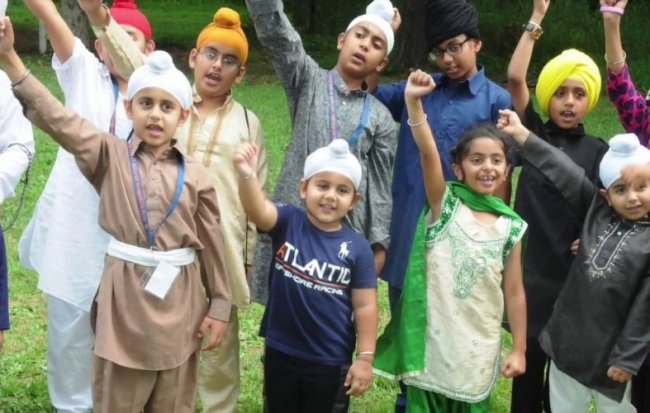We all know that a Gurdwara must have a prominent Nishan Sahib announcing the location of a Sikh “temple” or sanctuary. It must also have daily parkash of the Guru Granth Sahib. Besides these, what makes a building with a golden dome and a blue or kesri flag on a long colorful pole a Gurdwara?
For a Sikh, the external appearance of the building is not expected to matter. It is what happens inside the building that makes it a Gurdwara. Without the Gurbani kirtan, katha and path in the presence of the Guru Granth Sahib and an attentive sangat, and without the langar partaken in a discrimination-free pangat, it remains just an ordinary building. Equally important for Sikhs is what happens within us, in our hearts and minds, that truly makes the building a Dharamsaal.
In an ordinary building, the foundation is made of brick and stone, the main door usually opens into a welcoming physical space, people gather to strengthen social and cultural bonds, and the dining room caters mainly to the stomach. In contrast, a Gurdwara’s foundational purpose – and the core beliefs and spiritual and moral values of those who come there for guidance and comfort – rest firmly on Gurbani alone. The “dwaar to the Guru” is expected to lead to spiritual enlightenment, the people in the divan hall are the sadh sangat, and the langar hall is expected to help build bonds of brotherhood and sisterhood among equals. These religious beliefs and practices are expected to nurture Sikhi and a Sikh community. When all this happens, the seemingly-ordinary building gets transformed into a Gurdwara.
Knowing this, we expect a Gurdwara’s management committee and Granthis to keep the building in good shape and ensure that high-quality religious programs are undertaken on schedule. Kirtan divans, Akhand paths, Gurpurabs, Anand Karajs and other life-cycle events are expected to be undertaken in accordance with the prescribed Sikh Rehat Maryada. In addition, the Gurmat school and social events have to be organized to cater to the needs of the young and old. All this is done in most Gurdwaras; and when the organizers fall short in any way, the congregation rightly insists on corrective measures.
This is how it should be, for regular participation in programs at a well-managed Gurdwara satisfies a basic need of the community, and helps make us better Sikhs – but only if we do our part too. Neither a Gurdwara’s administration nor its religious programs and services can be effectively undertaken without the active engagement and strong contribution of dedicated Sangat members and volunteers.
Careful planning and deliberate effort are needed for accomplishing our personal and congregational goals at and through a Gurdwara. For a Gurmat school for example, a judicious mix of competent teachers, the latest educational technology, and sufficient time and effort devoted by diligent students jointly produces educational success. In Gurmat schools and Gurbani Vichar programs, the responsibility for learning and vichar is of the students and adults themselves. The same could be said of the kirtan- and katha programs in a Gurdwara. Passive participation or inattentive listening is not enough. A conscious and continuous effort to understand the meanings and implications of Gurbani is needed.
In essence therefore, what makes a mere building a Gurdwara is the conducive up-lifting environment and Sikhi-based programs and services it provides for learning and practicing Gurmat. Also needed are the synergistic purposeful efforts of all concerned – be they the granthi jatha, sangat members, teachers and students, community volunteers, or members of the Gurdwara management committee.
In the divan and langar halls, in the Gurmat school for youth, and in adult education programs, we need to always focus on and properly act upon the enlightening messages of the Guru Granth Sahib – for they teach us the Sikh way of life. Without this, we risk treating the Gurdwara as just an ordinary building.
*For recent related writings by the same author, see: Remembering Guru Nanak Ji, 28 Oct 2021: https://www.sikhnet.com/news/remembering-guru-nanak-ji; A Sikh’s Conversations with God, 10 Sept 2021: https://www.sikhnet.com/news/sikh%E2%80%99s-conversations-god; The Life and Legacy of Guru Nanak Sahib Ji, 15 Nov 2020: https://www.sikhnet.com/news/life-and-legacy-guru-nanak-sahib-ji; Celebrating Vaisakhi, 8 April 2021: https://www.sikhnet.com/news/celebrating-vaisakhi; and several books: Appreciating Sikhism (2008), Appreciating All Religions (2011), and Sikh Dharam (2015).





